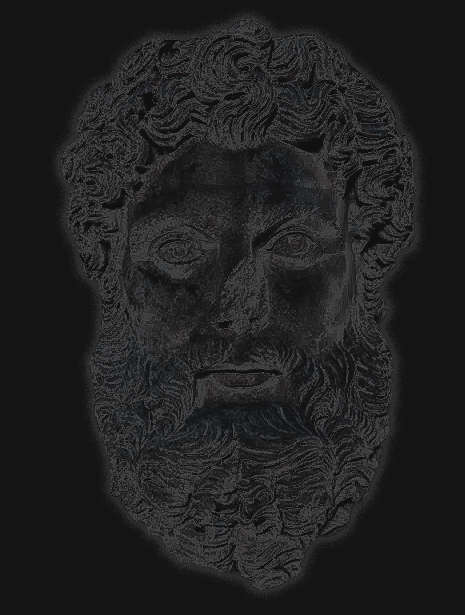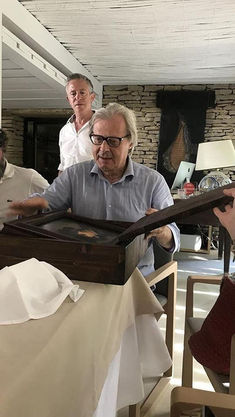"I had the pleasure of meeting Massimo in Rome, 2012, and later, when he stayed and worked as my assistant in my studio in Norway. He is technically very skilled and competent on the methods of the Old Masters. As an interlocutor he had philosophical abilities, something for which someone or rather everyone should envy him. I will never be able to praise him enough for his love for humanistic culture."
Odd Nerdrum
Text extracted from the speech given by Vittorio Sgarbi on the occasion of the inauguration of the exhibition "Solo l'Eternità", Città della Pieve, Palazzo della Corgna, 19 March 2016:
“Tizzano is a painter who shows great versatility and interest in the history of painting. A contemporary painter cannot fail to know ancient painting: in this Tizzano should be praised, because most contemporary artists know nothing, are ignorant, know nothing... The past has, instead, great artistic phenomena that are made of replicas and of reproductions: Roman art is a copy of Greek art, the neoclassical is a copy of the ancient world: neo-classical, in fact. The Renaissance is the re-birth of something that had already existed. So most of the authors of the past have always looked to others who had preceded them: the Mannerists were those who made the “manner” of Raphael and Michelangelo.
It follows that in every great artist there is a wealth of knowledge that needs the past to move towards the future.
.....
Normally a museum becomes such because it contains beautiful works: one goes to the Uffizi not only because Vasari made them, but because they are full of masterpieces. When instead you go to a museum of contemporary art, you make an act of faith: what’s inside, be it a portrait of Marilyn or Coca Cola, as the ones made by Andy Warhol, you think it’s a work of art because there is a museum that houses it. This position, so radically antagonistic, determined certain reflections in the young Tizzano: he rightly thought that before being a contemporary painter, he had to be an ancient painter, he had to be able to know the secrets of the ancient painters. He chose to run the risk of being referred to as a copyist, a repeater of things that have already done by others; but the Ro- mans and not even the neoclassicists have been certainly facing this problem: when Canova made a sculpture as beautiful as Phidias, he did not ask himself if it was something that had already been done, his problem was that it was done well!
.....
Tizzano certainly did not take the path of Morandi who said he had lived at five percent, painting very minimalist themes, very poor subjects: Tizzano tends to paint the human figure. In antiquity and until the mid-nineteenth century the most important painting was that of a historical, mythological, re- ligious subject, while still life and landscapes were second-rate paintings, “of genre”, as we said. Tizzano, on the other hand, tends to choose high painting: portraits, stories, reinterpreta- tions of myths and religious subjects, as shown by his painting “The doubt”. The choice that he then made by copying authors like Guido Cagnacci, is the choice of the human figure in its maximum expression, which is that of the female body.
.....
Starting from these prototypes, Tizzano creates new images, as great painters of our time did: I think of an American painter named Wyeth, I think of Balthus, who managed to tell an erotic intimacy in everyday subjects, in which however it is present the whole lesson of Piero della Francesca and of the great Italian painting.
.....
I admired Tizzano’s copies of Perugino, those of Antonello da Messina, Caravaggio, Rembrandt, Vermeer, Leonardo and other masters that he has studied trying to understand what is there not only in their craft, but in their soul. This represents a great, rare humility to look at history. Now he has projected himself towards totally original subjects with the skills of an ancient painter, trying his hand at the enterprise that not always succeeded, however, to the Pictor Optimus Giorgio de Chirico, who, while Burri and Fontana made rags and cuts, continued to paint the human figure, the female figure, sometimes also looked at with irony, but remaining a great painter of the first three decades of the twentieth century, as well as in subsequent works. He lived in time to try to tease the avant-garde, but was unable to establish himself with the strength with which succeeded Burri instead, who chose to come out completely from the classical Italian pictorial tradition. Tizzano, instead, he returns inside of it with the results that we see here. He has chosen a very perilous sea, a difficult road. For this reason I thought to recognize him the commitment and merit of those who do not want to forget the greatest story of beauty that has ever been conceived by man, that of Italian art: from Giotto to Canova we have not expressed anything but wonders that the whole world recognizes. We are a great coun- try thanks to our great artists; if you go to China, New York, Japan, you will find the great Italian artists: if they look at them today, it is strange that a painter of today does not look at them. So Tizzano has chosen the right path with regard to the humility to deal with them. I believe that first of all we must recognize this to him: it is for this reason that I am here today to testify for him."
Vittorio Sgarbi
Tizzano has been operating in the artistic and cultural sector for over ten years, dealing with the creation and reproduction of works of art according to traditional painting techniques, the prepara- tion of themed exhibitions, as well as the organization of practi- cal theoretical courses related to the ancient traditional techniques of oil painting.
In particular Tizzano is known for making master copies of the most beloved Masters of the most flourishing and significant peri- od of Western painting (14th / 17th century: Leonardo, Caravag- gio, Ver Meer, Rembrandt, Tiziano, etc.). The copies, faithfully realized according to the techniques and materials of the originals, as well as his original paintings, boast national and international awards and admirers and are present in prestigious collections.
To his credit he includes exhibitions in prestigious contexts and public recognition by critics, newspapers and international film productions (in 2017 he is interviewed by the chief editor of Rai Parlamento, for an episode aired on Rai 1 in the ambit of “7 giorni” program: in 2016 he is specifically reached in his study in Italy by the troupe of the Norwegian production documentary film “The hunt of Odd Nerdrum” for an interview later published within the second episode about Caravaggio).
The quality and quantity of Tizzano’s production as a copyist constitutes a one of a kind cultural heritage.
The exhibits set up enclose some of the greatest and most fa- mous masterpieces of Baroque-Renaissance painting, thus al- lowing the visitor an experience that is impossible to have otherwise: to admire in a single context museum quality repro- ductions of works of art to see which it would be needed go all over the world.
These are works carried out by hand and without the aid of any optical device except his eyes, retracing the compositional process of the originals themselves. Also for these reasons Vittorio Sgarbi, one of the most accredited and influent Italian art historian, de- fined him as one of the best copyists around.
His work retraces step by step the recipes and phases of the work in use in the Renaissance workshops: Tizzano maniacally prepares his own canvases and wooden supports, composes and applies the primers himself, grinds the colors by hand and realizes mediums and paints according to ancient formulas, with particular attention to the specific techniques of each Master.
































